To read earlier parts of this series Hockey’s Religious Foundations:
The Anglican Clergy turn a Suburban Game into a National Sport – Click HERE
Nonconformists Lead Hockey’s Downward Social Diffusion – Click HERE
The Quakers, like many of the Nonconformist denominations, saw the amateur game of hockey as an appropriate sporting pastime for both genders as the game lacked the brutality and overly competitive nature of other team sports. The Quaker Friends were particularly keen on mixed hockey, a game which had both men and women competing together and against each other and which challenged the masculinity of sport but reflected the spirit of Quakerism whereby women were treated as equals. Leeds and York Friends were playing mixed hockey as early as 1901. The York friends had two teams by 1904. Members of the Rowntree family both in Leeds and York were organising teams to play mixed hockey at the turn of the century. The Quaker schools across Yorkshire of had taken to hockey with enthusiasm. There were young boys in the playground of Ayton Friends School playing, the senior boys of Boothams and the girls of The Mount School in York were playing local hockey clubs and the Ackworth School in Pontefract had become a hockey nursery for the local Pontefract hockey club as the game was very much part of the Quaker school’s curriculum. The schools’ old boys and girls could be found playing locally and the Mount School old girls would form their own club The Mount Heath LHC.

Ayton Friends School
The Retreat Hockey Club
The Quaker founded and funded Retreat mental health hospital in York which since its foundation by William Tuke in 1792 led the field of mental health treatment in the UK would be engaged in sport. From its very beginning, the Retreat offered a humanistic approach to mental illness with none of the brutality that was commonplace in Victorian asylums The Quakers true to their beliefs believed the ‘inner light of God’ to be present in all so that the patients were considered as children and the Retreat as a loving family environment aiming to bring patients back to reason, and recovery. By the time Manchester born Quaker and St Bartholomew’s Hospital graduate Bedford Pierce arrived in 1892 as the medical superintendent the Retreat had shown that mental illness was curable. Pierce’s work on depression or melancholy as it was known then would add to the philosophy. He recognised the need for specialist training and built a nurses home on site and he valued the importance of outdoor physical exercise on the mental well-being of both patients and staff. Ellis in his study of the nearby North York asylum has shown that sport and sports facilities could attract nursing staff to work in asylums and help integrate the asylum into the local community removing it from the margins of society.[i]
Together with his two assistant medical superintendents, Dr Norah Kemp and Dr Henry James Mackenzie, Pierce set up cricket teams for men and ladies which were soon followed by men’s, ladies and mixed hockey matches on Wednesdays and Saturdays. In house mixed games were soon followed by the establishment of a hockey club in 1901. Dr Norah Kemp was the ladies secretary and Harold C. Hunt, a hospital clerk, the men’s secretary.
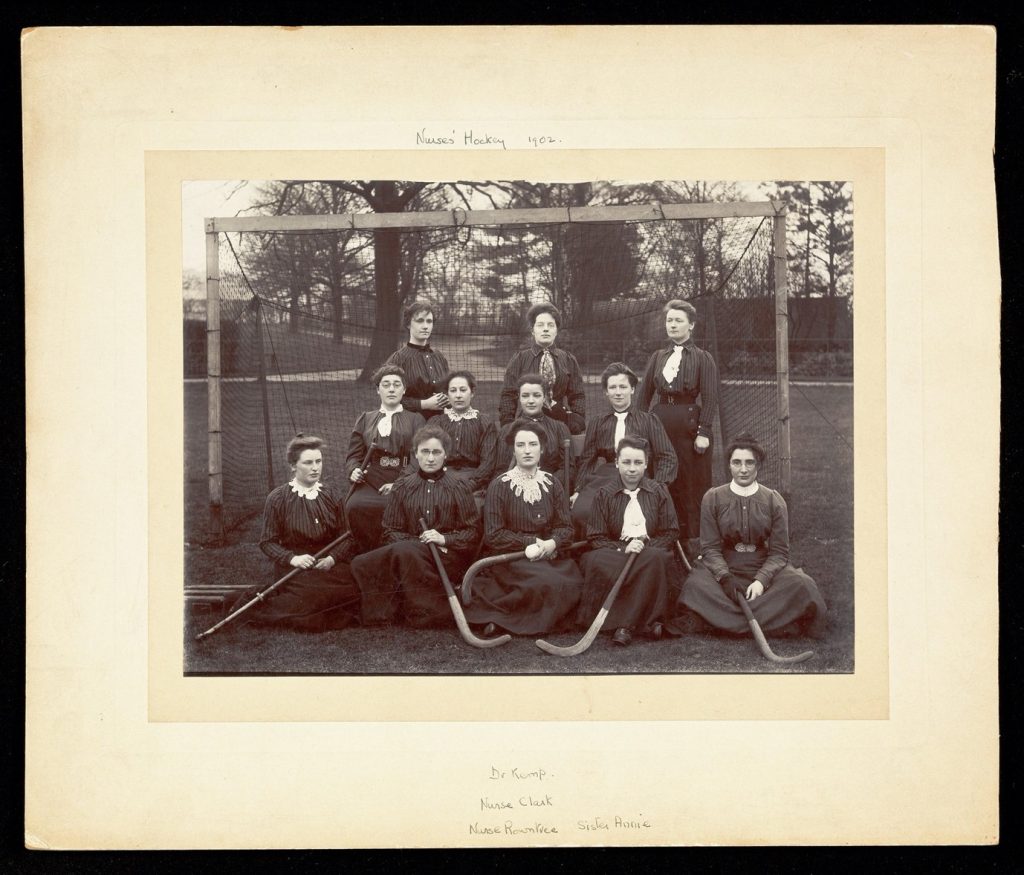
The Retreat Ladies Hockey Team 1902
Dr Norah Kemp is pictured in the centre of the back row
Source: Wellcome Library Ret1/8/4/15/2 Original held by Borthwick Institute for Archives University of York
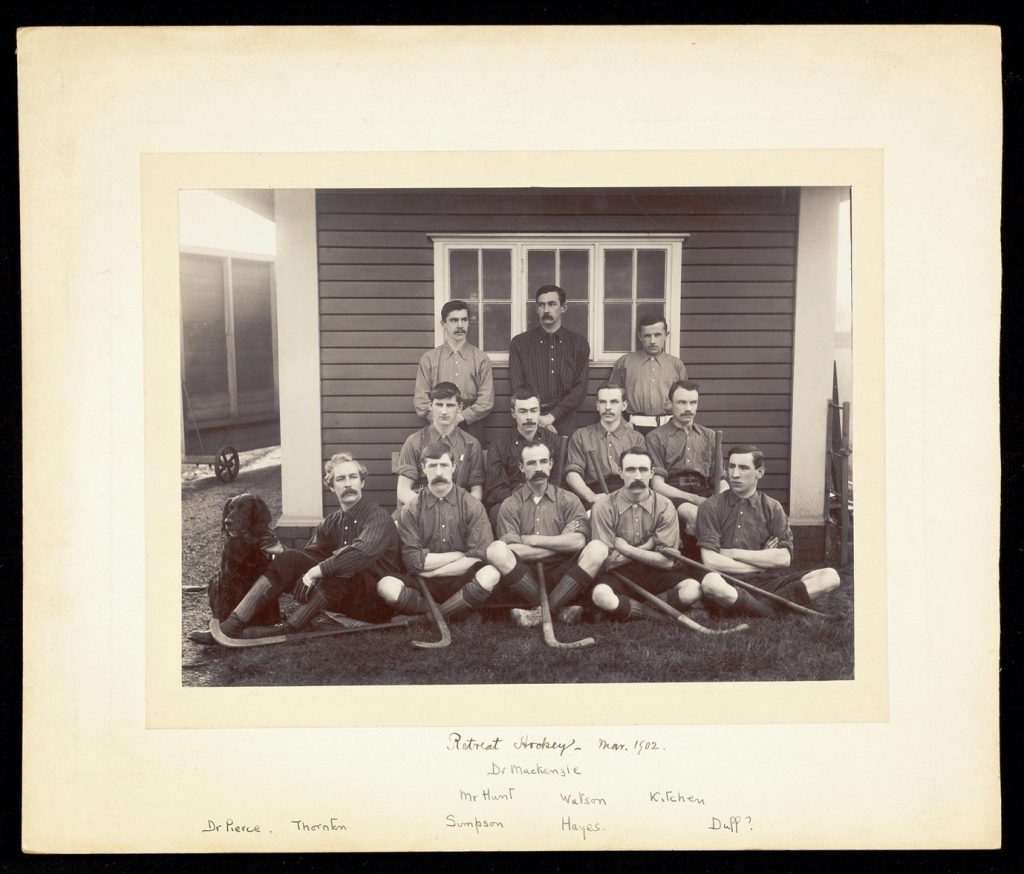
The 1902 Men’s Retreat Team
with Dr Bedford Pierce on the front row with the dog and Dr Henry J Mackenzie centre of the back row
Source: Wellcome Library Ret1/8/4/15/1 Original held by Borthwick Institute for Archives University of York
The 1902/3 season would see the club play eleven mixed, nine men’s and seven ladies’ matches:
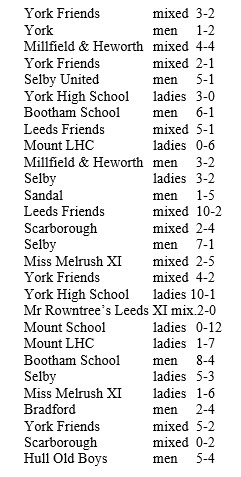
The 1902-3 fixtures highlight the popularity of hockey amongst the Quaker community of York.[ii] The number of fixtures would increase and by the 1912/13 season the club played 47 games winning 28 losing 15 and drawing 4.[iii] In addition, the club held numerous in-house mixed games such as the one in March 1907 when Age & Experience defeated Youth & Innocence 2-1. Great rivalry and commandry was exhibited between the York Friends
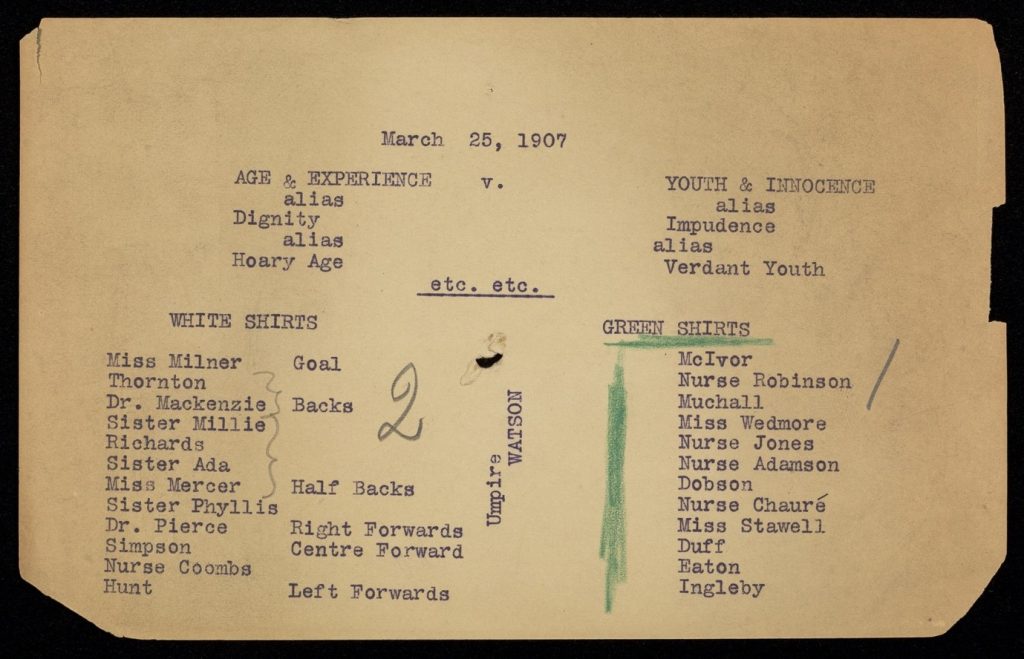
Source: wellcomelibrary.org Ret1/8/4/15/3 Original held by Borthwick Institute for Archives University of York
Meeting House team and the Retreat who would play each other on numerous occasions each season with the Retreat usually winning as reflected in part of a 1905 poem by the York Friends secretary William Arnold Whiting, a 19 year’s old ex Bootham School boarder from Leeds.
York Friends have got a hockey team on which they are rather sweet,
But tho’ they win all other games, they never beat Retreat
The list of wins last season shows really quite a feat
In fact, two losses all they had-those were, of course, Retreat
I don’t why they cannot win, I can only repeat
That tho’ they mostly beat a threat, they never beat Retreat
The Retreat was like a village with 300 inhabitants and sport was very much of a feature of life at the Retreat. They had cricket team from 1889, a ladies cricket team and played many in-house mixed matches just as they did in hockey. The Retreat’s growing fixture lists reflected the growing popularity of the game as before the First World War they played hockey against more than fifty clubs, the majority of which were local.[iv]
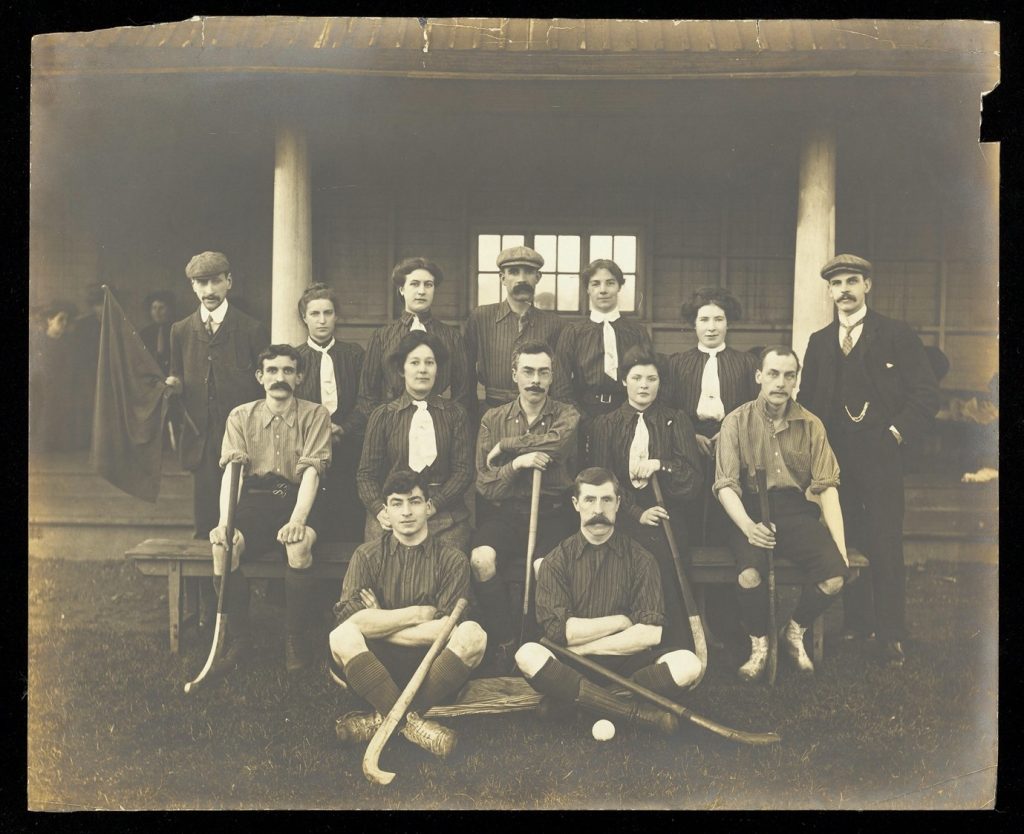
The Retreat Mixed Hockey Team November 1907
Source: wellcomelibrary.org Ret1/8/4/15/3 Original held by Borthwick Institute for Archives University of York.
A Quaker Sporting Thespian: Sir Frank R. Benson, his Shakespearean Touring Company and Benson’s Hockey Club.
Frank Benson was the great grandson of William Rathbone the Quaker Philanthropist and Liverpool merchant and son of William Benson a barrister and Hampshire landowner. Educated at Winchester school, Frank began treading the boards at Oxford University in 1881 when he first appeared to positive acclaim in Agamemnon of Aeschylus in the original Greek playing the part of Clytemnestra, wife of Agamemnon. Support from Ellen Terry and Henry Irving encouraged him to choose acting as a profession but before leaving Oxford in 1881 he would gain athletic fame winning the 3 mile race against Cambridge which would bring about Oxford’s first win over Cambridge at athletics.

Lizzie Caswall Smith (photographer)
Folger Shakespeare Library Digital Image Collection
http://luna.folger.edu/luna/servlet/s/0375zg
Benson’s professional career began by appearing in Irving’s Romeo and Juliet in 1882 before joining Walter Bentley’s touring company only for Walter to abscond with the company’s revenue to Australia leaving the company high and dry. Benson with £100 from his father would take over the company and it became the Benson Shakespearean Touring Company. Benson’s career as an actor manager had begun and would reach its pinnacle when in 1916 playing Julius Caesar at Drury Lane Theatre, he would be knighted in the royal box by King George V. From the very beginning of his management the Bensonians would be engaged in rehearsals in the morning and sport in the afternoon. Their sporting prowess at cricket and hockey was such that clubs sprang, dragon’s-teeth fashion, for the privilege of playing against the Bensonians.[v] It was claimed that to be a successful candidate for admission to the troupe one needed to be a rugger blue or could run a fast quarter mile or make a useful member of a cricket or hockey team as well as a talent for speaking verse. Benson’s philosophy of combining athleticism with aesthetics into a theory of acting was considered revolutionary but unpopular with the theatrical establishment.[vi] Benson’s plays were criticised for being overly athletic and actors muscle bound yet many of troupe like Oscar Asche, would go on to have great careers even if he had spent his afternoons as the hockey team’s goalkeeper.
The Bensonians were the first English hockey club to play in Ireland when they played the High School and Dublin University in early 1894.[vii] Their annual Christmas tour of Ireland would seem them play against Ireland’s top clubs such as Cliftonville who they once beat 3-1 with Asche in goal and Benson scoring a hat-trick from centre forward. Though hockey was preferred, the Bensonians could found playing rugby and even water polo. The leading hockey clubs across the country would face closely fought contests such as losing to Leeds HC 5-2 in a ‘fast and pleasant game’, winning 1-0 in Bournemouth and thrashing Kidderminster 6-1. Benson’s hockey club as it was known would build up a creditable reputation in the hockey world.

Source; Benson playing against Cliftonville
The Tatler 1st March 1905
Their sporting competitors would invariably be found in the evening’ audiences and the publicity surrounding their sporting events gave them free publicity as did Benson’s school afternoon performances. Touring was financially risky though overtime Benson’s company’s reputation grew to such a point that he had four companies touring the British Isles in 1906. The No. 1 company with Benson in the lead roles would perform in London, Stratford and the major cities whilst the other three companies named North, Midland, and South would perform in the provincial towns. Benson was never financially wealthy but over the years he built a successful reputation for promoting Shakespearean theatre across society and building up Stratford upon Avon’s reputation by participating in the annual Stratford Shakespeare Festival. Though never well acclaimed by the theatre critics, he probably enjoyed that other touring companies followed in his wake such as the Norman V. Norman Touring company who would play some 24 hockey matches in winter of 1905-6 increasing to 36 in 1907-08 proving that his philosophy of athleticism went hand in hand with the creative arts. It would seem that hockey playing thespians were regularly appearing across the country.
Quaker Companies support working women’s sporting emancipation
Though a relatively small religious community Quakers had a major role in the industrial revolution developing major national companies and were leaders in the welfare capitalism movement of the late Victorian and Edwardian era. Historians have highlighted the importance of the large Quaker owned confectionery companies such as Cadbury’s, Fry’s and Rowntrees in developing an enlightened view of capitalism whereby the well-being of their workforce was integral to the success of the company. Employing thousands of young women in their factories, these employers were concerned to create a community philosophy attempting to engender social progress via paternalism. Clubs and societies in domestic crafts appeared in the 1890s followed by sports facilities enabling swimming and gymnastics and team sports in the Edwardian era. Paternalistic objectives of developing healthy, moral and skilled model citizens were respected by the workforce but not always embraced as participation in team sports such as hockey appealed mainly to the more affluent female member of the companies.[viii] Nevertheless, Rowntrees would start a hockey club in 1911 which had thirty members paying annual subscription of 2 shillings and by 1912-13 the were playing ten other local clubs home and away.[ix] Cadbury’s started a club in 1905 with three teams rising to five teams by 1911. In 1924 one newspaper reported that “hockey is a game taken very seriously by the Fry’s firm and every Saturday ten or eleven teams of girls turn out to play.”[x] In the 1920s there were even annual fixtures between Frys of Bristol and Cadburys of Bourneville Birmingham.
These Quaker companies would play a significant role in the social diffusion and development of women’s hockey leading to the sporting emancipation of working women. In 1939 as war was underway the Quaker owned company the matchmakers Bryant & May in Liverpool would make a claim of being the largest hockey club in the land when its Diamond hockey club had seven teams in the Liverpool Ladies Hockey League and another two teams playing friendlies. Given that the Diamond factory had 800 female employees, the running of nine teams shows how popular hockey had become amongst working women.[xi] Unfortunately, a direct hit by a German bomber in the blitz of May 1942 would put an end to the factory and the hockey club. Nevertheless, these Quaker companies had by 1939 played a major part in the sporting emancipation of working women and promoting the game of hockey.
Appendix 1 The Retreat HC Opponents before 1914
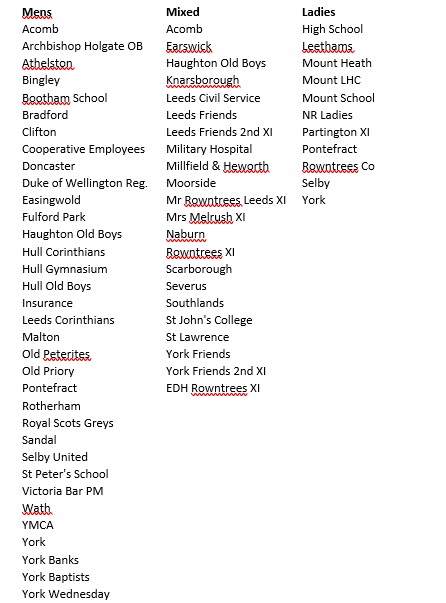
Article © of James Ormandy
Acknowledgements. Support and help form Mike Smith & Shane Smith of the Hockey Museum Woking
References
[i] R. Ellis Asylums and Sport: Participation, Isolation and the Role of Cricket in the Treatment of the Insane, The International Journal of the History of Sport, 30:1, 2013 p83-101,
[ii] wellcomelibrary.org Retreat Archive RET/5/15/3/1
[iii] wellcomelibrary.org Retreat Archive RET/5/15/3/1
[iv] Appendix 1
[v] J. C. Trewin Benson and the Bensonians (London, Barrie and Rockcliffe 1960) p80
[vi] J.W. Toth The Actor Manager Career of Sir Frank Robert Benson in perspective: An evaluation, Ohio State University Phd. 1971 p167
[vii] T.S.C. Dagg Hockey in Ireland (Tralee, The Kerryman Ltd 1944) p58
[viii][viii] C. M. Parratt “More than Mere Amusement” Working Class Women’s Leisure in England 1750-1914 (Boston Northwestern University Press 2001) p211
[ix] Parratt p209
[x] Wiltshire Times & Trowbridge Advertiser 22nd March 1924
[xi] Liverpool Echo 9th December 1939

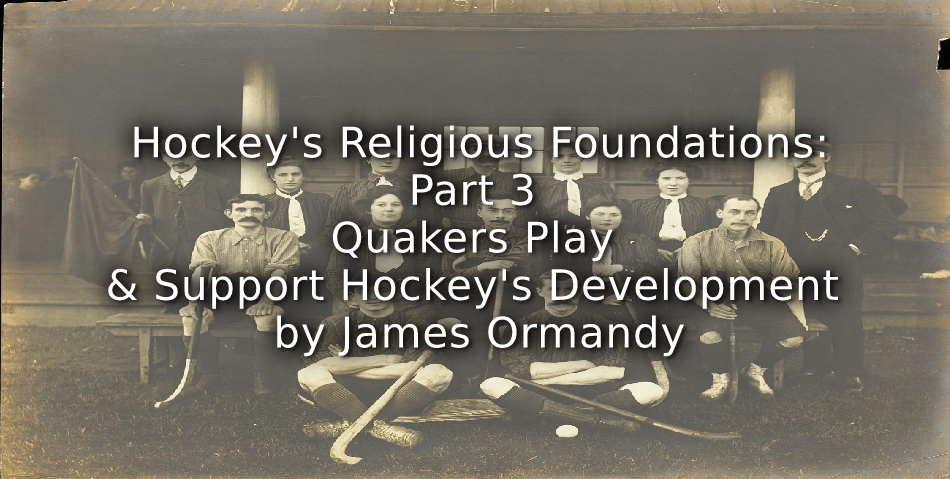
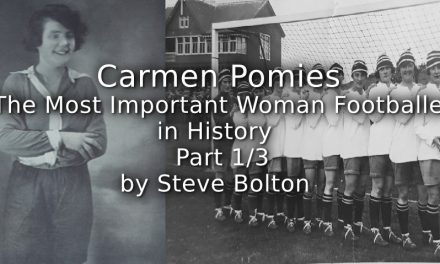
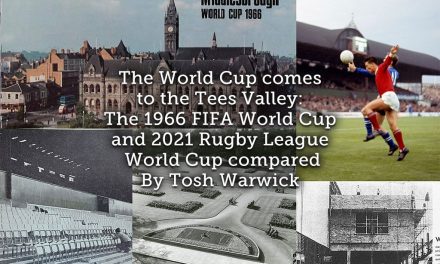
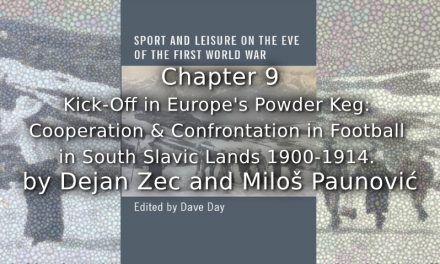
![I, Tonya, Cultural Capital and the American Dream [Spoiler Alert]](https://www.playingpasts.co.uk/wp-content/uploads/2018/02/tonyabanner-440x264.jpg)